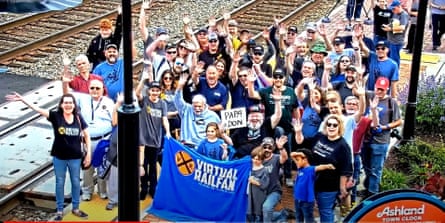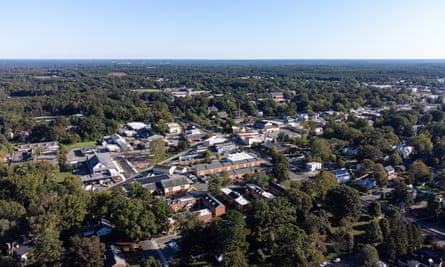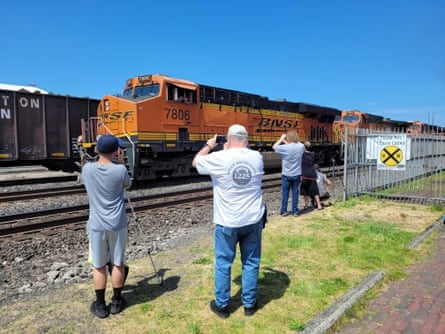
It was 4pm on a typical Tuesday in June, and hundreds of people sat waiting for the big moment: a train was passing through a rail station in La Plata, Missouri.
The viewers were not crowded around the platform, but in a chat room on an online stream. They consider themselves “virtual railfans” – a growing subculture that tunes into cameras affixed to stations across the United States and watches trains rolling through.
As the westbound boxcar locomotive powered through La Plata, the comments began to pour in: “That is FAST!” one viewer wrote. “He’s haulin’!” another agreed. “This is 65mph,” another said. Others breathlessly flooded the feed with fire emojis. As the last car disappeared from the camera, and the excitement dissipated one commenter summed up the experience: “And just like that,” he said. “It’s gone, and quiet.”
The world of railfans and trainspotters is hardly new. Since the advent of the railroad, hobbyists and professionals have taken photos of local trains, traveled to see their favorite railways, and simply passed the time sitting on platforms to enjoy the view.
But the community saw a digital boost during the pandemic, when the act of watching livestreams of trains soared in popularity. Many say they were drawn in by the community around the feeds, the romantic lore and history of rail travel in the US, and the regularity of trains passing through at a time when the world felt chaotic.
“A lot of people said during lockdown the camera really saved their sanity, because it was a way to connect with people they weren’t able to see in person at the time,” said Robert Scott, a railfan who volunteers as a moderator for a live camera in Chehalis, Washington. “Some people keep the feed on 24 hours a day in the background because they like the familiarity of the regular passing of trains.”
Today there are an increasing number of live rail-stream hubs, including RailwayCams, RailStream, and RailServe.com. One of the most popular is Virtual Railfan, founded in 2009 by a lifelong train obsessive named Michael Cyr. Cyr said he was sitting on the platform of a rail station in Folkston, Georgia – a small town with a big local railfan culture – when he realized his hobby could be brought online, allowing more people to engage. The following year, the first Virtual Railfan camera was set up in Folkston and attracted a few dozen viewers, a crowd that eventually grew to several hundred.
The company advertises itself as offering one of the most realistic online trainspotting experiences, featuring live audio and 1080HD cameras – many of which can be moved to see different angles of the incoming locomotives. “We wanted to bring the whole experience,” Cyr said. “If you can’t be there, we’re going to be the next best thing.” Virtual Railfan takes in revenue from paid memberships that offer additional features like playbacks of older streams and advertisements from its YouTube channels.


The fandom took off when Virtual Railfan migrated the streams to YouTube in May 2017, and at the urging of his growing viewer base, Cyr installed more cameras across the United States. Like many online services, Virtual Railfan saw activity explode when the pandemic hit, with numbers rising to a steady average of more than 20 million viewers per month. With 108 cameras in 31 states, Virtual Railfan now sees an average of 12 million viewers per month, hailing from more than 200 countries, according to Cyr. It’s largely an older crowd, with 60% of viewers over the age of 35.
Offline impacts
All this virtual trainspotting has created unexpected real-world impacts, bringing a much-needed boost of tourism to struggling railroad towns as fans journey to see their favorite locations in person.
Rail travel has been on the decline since it peaked in the first two decades of the 20th century, with the rise of plane travel and private automobiles fueling a stunning 84% drop in passenger rail travel between 1945 and 1964. The decline in travelers has persisted, with ridership decreasing 7% year over year between 2021 and 2022. This downturn has had major economic implications for the small towns that once dotted the railroad passageways of the United States.
Kathy Abbott, a local councilmember, said Virtual Railfan had had “a huge economic impact” on Ashland, Virginia – a city developed in the 1840s by the Richmond, Fredericksburg and Potomac Railroad as a stopping point on its 113-mile system. Abbott described the population-7,500 town as “charming” and “crazy quaint”, explaining that if you happen to pass it on the nearby interstate, “you just might miss it”.

After a popular stream set up at their local station, more than 500,000 viewers began to tune in each month. That interest has translated to an influx of tourism dollars, as thousands of fans have journeyed to Ashland from locales as far away as the UK and Germany to see the station in person – and, often, wave to their friends on the online stream.
Some online fans even plan “cam hopping” vacations, where they aim to stop by as many streams as possible across the US. Abbott said this year’s Train Day, an annual celebration of the town’s rail history that once hosted just a handful of participants, had brought in upwards of 20,000 real-life visitors.
And Ashland is not alone. Fort Madison, Iowa – the site of another popular stream – has seen a boom in visitors from its online stream, with the camera in the tiny river town of 10,000 people attracting a monthly average of more than a million viewers. One local hotel, the Kingsley Inn, reported its occupancy rate increased from 20% to more than 90% in the first year the camera was installed. In Chehalis, Washington, where another popular stream is based, the local railroad museum has seen an increase in patronage in recent years.

The phenomenon means once-skeptical cities are hopping on board, said Cyr. In the Georgia city where he launched the company, for instance, officials initially refused to host a camera at the station. But times have changed.
“Since all this growth has happened, the word has gotten out that these cameras have a major economic impact, and people are reaching out to us asking for streams,” he said.
People come to the cameras for a variety of reasons, Cyr said. Some viewers are interested primarily in the classic “choo-choo” of the train and observing what kinds of horns the locomotives use signal their arrival at the station. Others are “numbers guys”, painstakingly counting all of the cars on each train, with some trains exceeding two miles. There are also the more generalist fans, he said “who just love it all no matter what”. One woman in the chat said that because she was disabled and could no longer travel, watching the streams helped her get outside and see the world.

While viewers come for the trains, many stay for the community. Often the bulk of the minutes and hours involved in online trainspotting are spent waiting for locomotives to arrive. In the meantime, people use the accompanying chatrooms to get to know one another.
People ask about each other’s weekends, and their families. One day on the Ashland, Virginia, Virtual Rail Fans stream, a number of users asked a member who was having health struggles about her latest doctor’s appointment. On the La Plata, Missouri, stream, users gave a participant advice for traveling to see the station in person, reminding him to bring quarters for the vending machine on the platform.
Meredith Mark, 67, said she had begun watching the streams about two years ago, in retirement, as a way to pass the time and learn more about the history of railroads in the US. But once she started sitting in on the chatrooms, she became hooked on the community aspect of the hobby, and she now goes to in-person meetups at locations near her in Washington state several times a year.
“At first I was looking for beautiful scenery, and wildlife caught on some of the cameras. But the community was so welcoming and friendly, it kind of sealed the deal for me.” Now, she travels the country virtually by railroad camera, stopping by places she once visited in person, and watching streams from California, where she grew up.
“It’s a window into my home state, and my life,” she said. “It’s like I’m seeing it with new eyes.”



